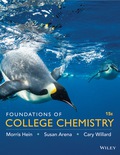
Concept explainers
(a)
Interpretation:
The percent of protons to the total mass of one selenium atom has to be given.
(a)
Answer to Problem 55AE
The percent of protons in a selenium atom is
Explanation of Solution
Given,
The mass of one selenium atom is
The mass of a proton is
The total number of protons in
The mass percent can be calculated as,
The percent of protons in a selenium atom is
(b)
Interpretation:
The percent of protons to the total mass of one xenon atom has to be given.
(b)
Answer to Problem 55AE
The percent of protons in a xenon atom is
Explanation of Solution
Given,
The mass of one xenon atom is
The mass of a proton is
The total number of protons in
The mass percent can be calculated as,
The percent of protons in a xenon atom is
(c)
Interpretation:
The percent of protons to the total mass of one Chlorine atom has to be given.
(c)
Answer to Problem 55AE
The percent of protons in a Chlorine atom is
Explanation of Solution
Given,
The mass of one Chlorine atom is
The mass of a proton is
The total number of protons in
The mass percent can be calculated as,
The percent of protons in a Chlorine atom is
(d)
Interpretation:
The percent of protons to the total mass of one Barium atom has to be given.
(d)
Answer to Problem 55AE
The percent of protons in a Barium atom is
Explanation of Solution
Given,
The mass of one Barium atom is
The mass of a proton is
The total number of protons in
The mass percent can be calculated as,
The percent of protons in a Barium atom is
Want to see more full solutions like this?
Chapter 5 Solutions
EBK FOUNDATIONS OF COLLEGE CHEMISTRY
- First image: Why can't the molecule C be formed in those conditions Second image: Synthesis for lactone C its not an examarrow_forwardFirst image: I have to show the mecanism for the reaction on the left, where the alcohol A is added fast in one portion Second image: I have to show the mecanism of the reaction at the bottom. Also I have to show by mecanism why the reaction wouldn't work if the alcohol was primaryarrow_forwardFirst image: I have to explain why the molecule C is never formed in those conditions. Second image: I have to propose a synthesis for the lactone Aarrow_forward
- 20.44 The Diels-Alder reaction is not limited to making six-membered rings with only car- bon atoms. Predict the products of the following reactions that produce rings with atoms other than carbon in them. OCCH OCCH H (b) CH C(CH₂)s COOCH མ་ནས་བ (c) N=C H -0.X- (e) H C=N COOCHS + CH2=CHCH₂ →→arrow_forwardGiven the attached data, provide the drawing for the corresponding structure.arrow_forwardno Ai walkthroughsarrow_forward
 Chemistry: The Molecular ScienceChemistryISBN:9781285199047Author:John W. Moore, Conrad L. StanitskiPublisher:Cengage Learning
Chemistry: The Molecular ScienceChemistryISBN:9781285199047Author:John W. Moore, Conrad L. StanitskiPublisher:Cengage Learning Introduction to General, Organic and BiochemistryChemistryISBN:9781285869759Author:Frederick A. Bettelheim, William H. Brown, Mary K. Campbell, Shawn O. Farrell, Omar TorresPublisher:Cengage Learning
Introduction to General, Organic and BiochemistryChemistryISBN:9781285869759Author:Frederick A. Bettelheim, William H. Brown, Mary K. Campbell, Shawn O. Farrell, Omar TorresPublisher:Cengage Learning General Chemistry - Standalone book (MindTap Cour...ChemistryISBN:9781305580343Author:Steven D. Gammon, Ebbing, Darrell Ebbing, Steven D., Darrell; Gammon, Darrell Ebbing; Steven D. Gammon, Darrell D.; Gammon, Ebbing; Steven D. Gammon; DarrellPublisher:Cengage Learning
General Chemistry - Standalone book (MindTap Cour...ChemistryISBN:9781305580343Author:Steven D. Gammon, Ebbing, Darrell Ebbing, Steven D., Darrell; Gammon, Darrell Ebbing; Steven D. Gammon, Darrell D.; Gammon, Ebbing; Steven D. Gammon; DarrellPublisher:Cengage Learning Chemistry: An Atoms First ApproachChemistryISBN:9781305079243Author:Steven S. Zumdahl, Susan A. ZumdahlPublisher:Cengage Learning
Chemistry: An Atoms First ApproachChemistryISBN:9781305079243Author:Steven S. Zumdahl, Susan A. ZumdahlPublisher:Cengage Learning Chemistry for Engineering StudentsChemistryISBN:9781337398909Author:Lawrence S. Brown, Tom HolmePublisher:Cengage Learning
Chemistry for Engineering StudentsChemistryISBN:9781337398909Author:Lawrence S. Brown, Tom HolmePublisher:Cengage Learning Chemistry & Chemical ReactivityChemistryISBN:9781337399074Author:John C. Kotz, Paul M. Treichel, John Townsend, David TreichelPublisher:Cengage Learning
Chemistry & Chemical ReactivityChemistryISBN:9781337399074Author:John C. Kotz, Paul M. Treichel, John Townsend, David TreichelPublisher:Cengage Learning





